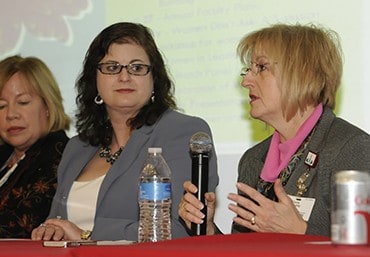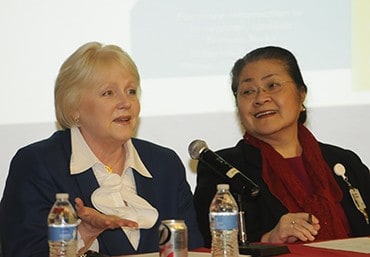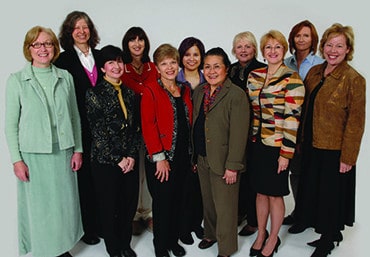Women’s Faculty Caucus Looks Back on 25 Years of Service
| 
Former WFDC president Mary Aitken, M.D., M.P.H., and current president Wendy Ward, Ph.D., listen while Dana Gaddy, Ph.D., comments on the work of the caucus through the years.

Debra Fiser, M.D., the WFDC’s first president, discusses the organization’s founding and goals while Terry Angtuaco, M.D., the second president, smiles in recollection.

Most of the women who have served as WFDC president are shown in this 2008 group photo. Some held other offices in the caucus at the time. From left: Cindy Kane, Ph.D.; Debra Simmons, M.D.; Linda Worley, M.D.; Laurie Barber, M.D.; Paula Anderson, M.D.; Sara Tariq, M.D.; Terry Angtuaco, M.D.; Debra Fiser, M.D.; Dana Gaddy, Ph.D.; Kathleen Gilbert, Ph.D.; and Mary Aitken, M.D., M.P.H. Not shown: Jeanne Heard, M.D., Ph.D., and current president Wendy Ward, Ph.D. All but Simmons and Barber are still at UAMS.
Feb. 28, 2014 | Remember 1989? Bill Clinton was governor in Arkansas and George H.W. Bush became president. Acid-wash jeans and fluffy bangs were trendy. “The Cosby Show” was tops on television, and Bette Midler’s rendition of “Wind Beneath My Wings” was rising on the charts.
Midler’s uplifting ballad would prove to be inspirational for a group of women faculty members in the UAMS College of Medicine who formed an organization that year to support one another’s efforts to succeed in a male-dominated field.
Twenty-five years later, the Women’s Faculty
Development Caucus (WFDC) is stronger than
ever – and supporting the professional development
of both women and men on the faculty in the College
of Medicine and throughout UAMS. The caucus
launched a year-long anniversary celebration with a
recent panel discussion featuring 10 of the 13 women
who have served two-year terms as WFDC president.
“Our mission is to inspire, encourage and enable
women on our faculty to realize their
professional and personal goals,” said moderator Laura Sisterhen, M.D., an associate professor in the Department of Pediatrics who currently serves as vice-president. “Through the caucus’ services and activities we have helped countless faculty members achieve their goals.”
Sisterhen drew knowing laughs from the panel and audience when she noted some of the trends of 1989. But the song “Wind Beneath My Wings” resonated most for WFDC members.
“The song really fits with what we were doing at the time,” said Debra H. Fiser, M.D., who
was the WFDC’s first president and rose
through the ranks of the faculty to chair the
Department of Pediatrics for 11 years before
serving as dean of the College of Medicine and vice chancellor of UAMS from 2006 to May 2013.
Fiser, who has returned to the Department of Pediatrics, recalled her early, personal experience with the complex, then-unfamiliar academic promotion and tenure process. Prior to the WFDC’s formation, formal guidance was very limited and many women faculty members did not feel included in the informal networks of their male peers. Fiser drew support from a group of women in her department and gained insights into national efforts to address issues such as salary equity, professional development and other needs of women faculty members while serving as UAMS’ women’s liaison officer to the national Association of American Medical Colleges (AAMC).
“I felt like there were things that we could do by pulling together people from across other departments – because there were so few senior women faculty members – and that we could tap everyone else’s knowledge and just help each other,” Fiser said. The dean at the time, I. Dodd Wilson, M.D., enthusiastically supported her proposal to form a college-wide women’s professional development group, and the WFDC was born.
The caucus introduced a steady stream of services, including a comprehensive formal mentoring program. An annual day of development workshops for women segued into a Professional Development Day for all faculty members, and many special programs focusing on topics such as promotion and tenure, as well as informal gatherings, are held throughout the year.
The group has tackled important issues affecting women on the faculty, such as extending the maximum time allowed to achieve required milestones on the path toward promotions or tenure, to offset time away during maternity leave. The caucus periodically conducts and analyzes salary data within departments to help ensure equity among male and female colleagues.
The WFDC produces a popular handbook of UAMS and local resources for all new faculty members and medical residents who come to UAMS for training. The group also works with and supports medical students.
In 1997, the WFDC received the first-ever Women in Medicine Leadership Award from the AAMC in recognition of its professional development activities.
Two former WFDC presidents on the panel commented on different ways to view the progress of women faculty locally and nationally in the past 25 years.
Terry Angtuaco, M.D., a professor in the Department of Radiology who worked with Fiser to shape the WFDC and served as its second president, said that much has been accomplished. However, she noted that this is still an era where the appointment of a woman to a top leadership post often garners special notice as a “first” for women.
“We probably need to assess how far we have come, because the issues we talked about (25 years ago) are the issues we still talk about,” Angtuaco said.
At UAMS, one mark of progress has been the growth of women on the faculty and in top leadership positions, said Jeanne Heard, M.D., Ph.D., who followed Angtuaco as WFDC president in 1993-1995. In 1989, about 20 percent of the college’s faculty members were women, two women served as department chairs, and none of the college’s top posts – the dean and associate deans – were held by women.
Today, 44 percent of faculty members are women. Seven women currently serve as department chairs, two are associate deans, and women hold numerous other top posts as well. Heard, a former associate dean in the college, returned to UAMS in 2010 after serving as a senior vice president at the Accreditation Council for Graduate Medical Education, the national organization that accredits U.S. residency programs. She now serves as provost and chief academic officer for all of the colleges at UAMS.
While professional advancement, networking and leadership preparation have been mainstays for the WFDC, several former presidents on the panel also lauded the organization’s role in helping them to manage “life balance” and issues relating to their roles as parents and spouses.
Like many of her colleagues, psychiatrist Linda Worley, M.D., went on to leadership posts in regional and national organizations as well as UAMS programs. She was WFDC president in 2001-2003.
“You have been my survival guide for both the formal rules of how you survive and thrive (in academic medicine) and the informal rules of how to balance it all,” Worley told her WFDC colleagues. “This group prepared me to become a leader. You gave me those wings, and I can’t thank you enough.”